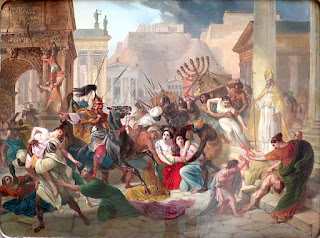Ricimer was a Roman general, but like many Romans, he was not Latin, but German. He is usually described as a Goth by his contemporaries, but sometimes as the product of a Suevic father and a Visigothic mother. Some surmise that he was the son of a marriage alliance between the two Germanic tribes. His sister married a Burgundian king, Gondioc, giving Ricimer additional powerful ties. The chaos that followed the sacking of Rome allowed Ricimer to consolidate military hold over much of the Western Empire.
The Battle of Agrigentum was a success for Ricimer: the Vandals retreated to their ships to escape, but Ricimer followed and defeated them in a naval battle off the coast of Corsica. A year later, a Vandal army after looting Campania (the "shin" of Italy) was ambushed and defeated by forces of the Western Emperor Majorian. Majorian was a full-blooded Roman who had been a general and achieved the throne with the support of Ricimer and another general.
Majorian made it a primary goal to defeat the Vandals decisively. His first attempt, an attack on Cartagena in 460, failed. An alliance between the Western and Eastern Empires in 468 sent (supposedly) over 1000 ships and over 50,000 soldiers. The Vandals used fireships—ships filled with combustibles, set on fire, and sent into the opposing flat to do damage and cause chaos—to disrupt the Roman navy. Over 100 ships and over 10,000 Romans died. Rome's chances of achieving any kind of domination over the Vandals faded after that.
In the 470s, Ricimer negotiated a treaty with the Vandals. Genseric ruled the Western Mediterranean from Gibraltar to Tripoli. The Vandals started minting their own coinage, although it was only low-denomination bronze and silver coins. They adopted Roman coinage when higher value was needed. When Genseric did in 477, his son Huneric took over.
Huneric was married to Eodocia, the daughter of the Roman Emperor Valentinian III. A fervent Arian, he nonetheless allowed some tolerance to other groups, allowing the Catholics to elect a bishop (a position that had not been filled in 24 years). He did persecute Manichaeans, however, and later in life returned to harassing Catholics, exiling their bishops and trying to force conversions to Arianism.
Under Huneric and his successors, the Vandals lost much of the territory that had been conquered under Genseric. The Ostrogoths took most of Sicily. The rising presence of Moors in the Iberian Peninsula chipped away at Vandal control of the Western Mediterranean. The Vandal King Hilderic (523 - 530) was too tolerant to Catholics, creating a civil war when a strong Arian faction overthrew him, making Hilderic's cousin Gelimer king and throwing Hilderic into prison.
The Byzantine Emperor Justinian then stepped in on Hilderic's behalf. Tomorrow we'll see the result, and the dissolution of the Vandal Kingdom.



























